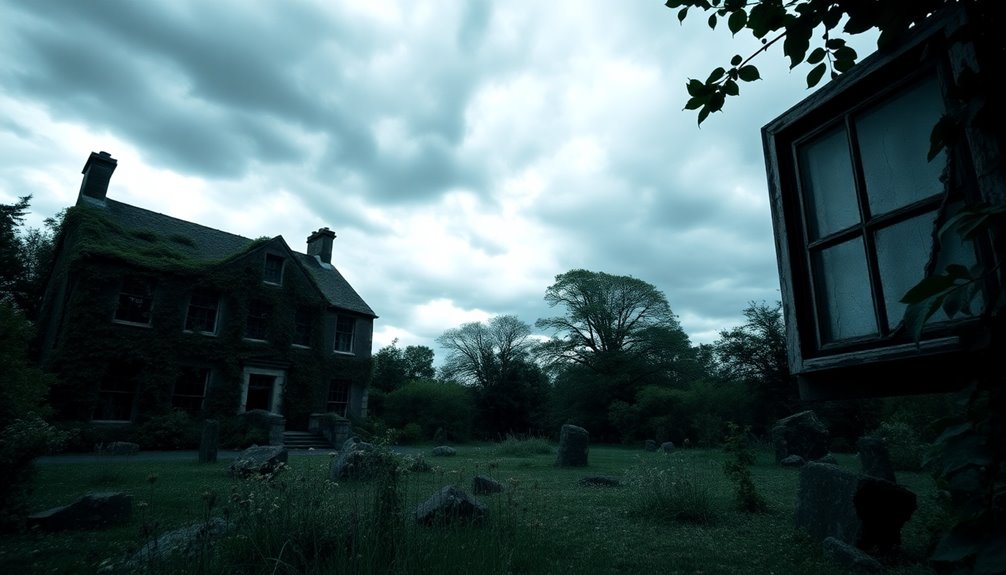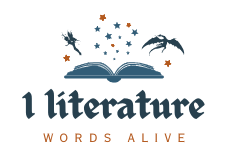In *The Thirteenth Tale*, you meet the mysterious author Vida Winter and biographer Margaret Lea, who's drawn into Vida's haunting past at Angelfield estate. As they explore hidden truths and family secrets, the narrative reveals the complexities of identity and loss. You'll uncover the tragic lives of twins Adeline and Emmeline, and how their stories intertwine with Margaret's own grief. Keep going, and you'll discover even deeper connections and revelations in this gothic tale.
Overview of the Novel

*The Thirteenth Tale* immerses you in a world of secrets and shadows through the life of the enigmatic author Vida Winter.
In this gothic novel by Diane Setterfield, Vida hires biographer Margaret Lea to reveal her mysterious past, filled with deception and loss.
The narrative unfolds in four sections—Beginnings, Middles, Endings, and again Beginnings—enhanced by photographs that hint at deeper truths. This exploration of resilience and strength emphasizes how personal struggles can shape one's identity, echoing the way that the legacy of Rebecca influences character actions and relationships.
As you follow Margaret's journey, you'll discover her struggles with her twin's death, mirroring Vida's traumatic childhood at the eerie Angelfield estate.
Themes of identity, memory, and the complexities of familial relationships emerge, questioning the very nature of truth in storytelling.
This enthralling tale pulls you into a labyrinth of intertwined lives and haunting revelations, reminiscent of the Gothic atmosphere that captivates readers in *Rebecca*.
Main Characters and Their Relationships
In *The Thirteenth Tale*, the intricate web of relationships among the main characters reveals the depths of their struggles and connections.
Margaret Lea, an amateur biographer haunted by the loss of her twin sister, seeks to understand her own identity through the stories of others. This quest for self-discovery mirrors the journeys of strong female protagonists in historical fiction, where women often navigate their identities against the backdrop of societal expectations. The exploration of identity and personal history resonates with themes found in *Unbroken*, emphasizing the importance of resilience in the face of extreme adversity.
Vida Winter, the enigmatic novelist, invites Margaret to uncover her true history, revealing how their lives intersect through themes of loss and family trauma.
The twins, Adeline and Emmeline, embody the complexities of familial bonds with their contrasting personalities shaped by the dysfunction of Angelfield.
As secrets unfold, Margaret and Vida's relationship deepens, illustrating how shared experiences of grief and identity can connect even the most disparate lives. This exploration of resilience amidst adversity echoes the struggles faced by characters in other narratives, such as those in *The Book Thief*.
The Setting of Angelfield

While exploring Angelfield, you can't help but feel the weight of its decaying grandeur. The Angelfield estate looms with gothic elements, its dark corners and neglected garden whispering family secrets.
As you wander through its eerie halls, the atmosphere thickens with a sense of madness and tragedy, especially following the twins' mother, Isabelle's, departure to an asylum. You sense the lingering loss that permeates the air, a reflection of the family's dysfunction and isolation. The estate's setting echoes the gothic literature that reveals dark, atmospheric settings filled with lurking secrets. The intricate plotting and rich historical detail found in historical mystery novels enhance the experience of uncovering the estate's hidden truths.
The architecture, once beautiful, now stands as a haunting reminder of the lives entwined within its walls. Each room reveals fragments of the past, inviting you to uncover the mysteries that shape the twins' wild upbringing and the estate's tragic legacy. The breakdown of societal norms within the estate mirrors the characters' descent into chaos, revealing the fragility of their familial bonds.
Themes of Identity and Loss
Identity and loss intertwine deeply in "The Thirteenth Tale," shaping the lives of its main characters. You see how Margaret Lea grapples with her identity, haunted by the loss of her twin, which underscores the profound bond they shared. This loss leaves her feeling incomplete and searching for belonging. Additionally, the exploration of memory's influence on personal growth highlights how understanding one's past can lead to healing. The journey through personal growth often reveals hidden reserves of resilience that empower individuals to navigate their complexities.
Similarly, Vida Winter's constant reinvention of herself reveals her struggle with family secrets and the trauma that fractures her identity. As you explore their stories, you witness how their pasts dictate their present.
Ultimately, the narrative emphasizes that reconciliation with their histories is essential for both characters. Through this reconciliation, they begin to reclaim their identities and confront the shadows of loss, paving the way for healing and self-discovery. This journey resonates with the themes of resilience found in literature, illustrating how personal growth can emerge from hardship.
The Structure of the Narrative

In "The Thirteenth Tale," you'll notice the non-linear storytelling that keeps you engaged as it unfolds Vida's complex past. The shifts in character perspectives between Vida and Margaret challenge you to question the truth behind their narratives. This structure not only enhances the mystery but also deepens your understanding of memory and identity. The intricate plots and unreliable narrators throughout the novel contribute to an immersive experience that keeps you guessing until the end. Additionally, the exploration of suburban disillusionment mirrors the internal conflicts faced by the characters as they navigate their intertwined stories. The theme of identity and self-discovery resonates deeply, reflecting the characters' journeys as they confront their pasts and seek to understand their true selves.
Non-linear Storytelling Approach
As Vida Winter shares her story, the non-linear storytelling approach of *The Thirteenth Tale* captivates you, drawing you into a complex web of past and present.
The narrative unfolds in four sections—Beginnings, Middles, Endings, and again Beginnings—where each title page hints at upcoming events. This non-chronological structure intertwines Vida's life with Margaret Lea's, creating a layered exploration of identity and memory.
You notice graphic indicators signaling shifts between characters, enhancing your understanding of the narrative's intricacies. The first-person perspectives prompt you to question the reliability of the stories, making you ponder the nature of truth itself.
This intricate structure not only engages you but also deepens the themes woven throughout the tale.
Character Perspective Shifts
While reading *The Thirteenth Tale*, you quickly realize how the character perspective shifts enrich the narrative. These shifts between Vida Winter and Margaret Lea create a vivid tapestry of intertwining stories, revealing layers of memory and identity.
You'll notice:
- Asterisks signaling time's passage
- Photographs hinting at hidden truths
- Contrasting narratives that challenge your trust
- A journey through the fog of memory
- The haunting echoes of the past
This non-linear storytelling invites you to question truth and deception, as each character's perspective offers a unique lens on their shared history.
As you navigate their worlds, you uncover secrets that transform both their identities and your understanding of the tale.
The Role of Storytelling and Memory
In *The Thirteenth Tale*, you see how storytelling shapes identity and influences the truth of memories.
As Vida and Margaret share their narratives, you realize that their stories not only reveal their pasts but also offer a form of immortality.
This exploration prompts you to question how memory intertwines with the tales we tell, ultimately shaping our understanding of ourselves.
Power of Narrative
Storytelling serves as a powerful tool for shaping identity and confronting the past, especially in "The Thirteenth Tale."
Through the intertwined lives of Vida Winter and Margaret Lea, the novel illustrates how narratives can transform personal histories, revealing the complexities of memory.
The power of narrative unfolds through:
- Vida's elaborate fabrications that blur truth and fiction
- Margaret's reflections as a biographer capturing fleeting moments
- The reconciliation of loss through shared tales
- The emotional healing that arises from confronting painful pasts
- The immortality granted to stories, echoing through time
As you explore their stories, you'll discover how storytelling not only shapes identities but also provides a pathway toward understanding and healing from isolation and grief.
Memory's Influence on Truth
Memory profoundly influences our understanding of truth, as seen through the lens of "The Thirteenth Tale."
Characters like Vida Winter and Margaret Lea grapple with their pasts, revealing how memories can be reshaped to serve emotional needs or protect one's identity.
Vida's fabrications showcase the malleability of memory, illustrating how personal narratives can twist to conceal painful truths.
Meanwhile, Margaret's role as a biographer highlights the challenge of capturing an accurate life account, exposing the inherent biases in memory.
As the narrative unfolds, storytelling emerges as a cathartic process, allowing characters to confront their intertwined histories.
Ultimately, the interplay of memory and storytelling reveals deeper truths, shaping their identities and helping them reconcile their pasts.
Storytelling as Immortality
Characters in *The Thirteenth Tale* reveal how storytelling can transcend mortality, preserving their truths long after they're gone. Through the lens of memory, they explore the delicate balance between authenticity and imagination.
You'll witness:
- The weight of unspoken secrets lingering in the air
- Vivid memories that shape identities and relationships
- The ink of a pen capturing fleeting emotions
- The echo of voices that refuse to fade away
- The intertwining of reality and fiction, creating a rich tapestry of life.
As Vida Winter shares her story with Margaret, you understand that each narrative not only immortalizes experiences but also challenges the accuracy of memory.
Storytelling becomes a bridge between the past and present, ensuring that their legacies endure.
Gothic Elements Present in the Tale
The haunting atmosphere of the Angelfield estate instantly immerses you in the Gothic elements of "The Thirteenth Tale."
Its dilapidated structure and shadowy corners evoke a sense of foreboding, setting the stage for a narrative steeped in secrets and madness.
As a Gothic novel, the story unravels deeply buried family secrets, exploring themes of isolation and tragedy.
You'll encounter characters grappling with a past filled with disappearance and scandal, enhancing the eerie tone.
The supernatural lingers just beneath the surface, creating suspense that draws you further into the plot.
Motifs of identity and duality, especially through the twins Adeline and Emmeline, reflect the psychological complexity typical of Gothic storytelling, inviting you to ponder the nature of self and other.
Reader Reception and Critical Acclaim
While it's easy to get lost in the haunting narrative of "The Thirteenth Tale," readers and critics alike have praised its gripping storytelling and rich Gothic atmosphere.
The book quickly became a No. 1 New York Times Best Seller, showcasing its widespread appeal.
- Enigmatic characters steeped in mystery
- A crumbling manor whispering dark secrets
- Twisting plots that keep you guessing
- A fascinating narrative that envelops you
- Audiobook performances that bring the tale to life
Kirkus Reviews called it an "enchanting contemporary Gothic tale," while Library Journal highlighted its strong engagement and gripping nature.
Despite some critiques about literary formulas, the overall reader reception and critical acclaim celebrate its compelling story and character development.
Literary Connections to Classic Works
Literary connections in "The Thirteenth Tale" enrich its narrative, weaving references to classic works that enhance its themes.
You'll notice parallels between the isolation and identity struggles in "The Thirteenth Tale" and Charlotte Brontë's "Jane Eyre," particularly through the character of Hester Barrow, a governess akin to Jane.
The novel employs Gothic elements reminiscent of "Wuthering Heights," deepening the exploration of family secrets and tragic histories.
Vida Winter's storytelling mirrors the complexity of Victorian literature, showcasing unreliable narrators and questioning the nature of truth.
Additionally, the themes of memory and storytelling echo Henry James's "The Turn of the Screw," blurring the lines between reality and fiction.
These connections create a rich tapestry of literary homage throughout the novel.
Lasting Impact and Reflections
As you read "The Thirteenth Tale," you can't help but feel the emotional weight of the secrets that shape each character's identity.
The exploration of who we're in the shadow of family dynamics and hidden truths hits close to home, prompting you to contemplate your own experiences.
This novel's profound themes resonate long after you turn the last page, inviting you to ponder the complexities of your own story.
Emotional Resonance of Secrets
Secrets wield a profound emotional resonance in *The Thirteenth Tale*, shaping the identities of its characters and influencing their journeys. You see how these hidden truths affect their lives:
- Margaret's struggle with her twin's death, feeling incomplete.
- Vida Winter's fabricated stories as shields against trauma.
- The isolation stemming from familial neglect and emotional distance.
- The tragic separation of Adeline and Emmeline, leading to lifelong turmoil.
- The ultimate quest for liberation through confronting buried secrets.
These elements intertwine to reveal how secrets not only fracture identities but also anchor the characters in their emotional struggles.
The novel underscores that true healing demands reconciling with the past, providing a path to emotional liberation and personal growth.
Themes of Identity Exploration
The emotional weight of hidden truths not only influences relationships but also drives characters to explore their identities.
In "The Thirteenth Tale," both Margaret Lea and Vida Winter face their pasts, unearthing family secrets that shape their personal identities. Margaret's struggle with her twin's death leaves her feeling incomplete, prompting an extensive exploration into her own sense of self.
Meanwhile, Vida's fabrications reveal the complexities of identity exploration and how stories can redefine one's truth.
The intertwined fates of the twins, Adeline and Emmeline, highlight the profound impact of familial connections on identity. As both women confront their histories, they ultimately find reconciliation, underscoring how understanding one's identity is essential in maneuvering the shadows of hidden truths.
Conclusion
You might think a gothic novel wouldn't hold your interest, but "The Thirteenth Tale" proves otherwise. Its intricate layers of mystery and rich character dynamics pull you in, making you keen to uncover the secrets of Angelfield. As you journey through themes of identity and loss, you'll find yourself reflecting on your own life. This isn't just a tale of ghosts; it's a poignant exploration of what it means to truly know oneself. Don't miss it!



